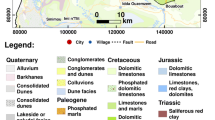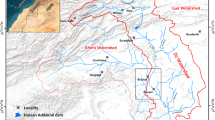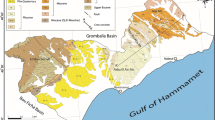Abstract
A climatic water balance study, along with an analysis for stable isotopes (oxygen-18 and hydrogen-2), and hydrogeochemical signatures were together used to understand the groundwater recharge environment and hydrogeochemical processes in the semi-arid region of Gooty Mandal, District of Anantapur, India. The study revealed that the annual potential evapotranspiration was thrice the annual rainfall, indicating the influence of evaporation both during rainfall and after infiltration resulting in the enrichment of salts in the soil and the stable isotopes in shallow groundwater. Stable isotopic signatures suggest that the source of groundwater recharge is contributed by several components and not just direct precipitation. The argument is further supported by the relation between oxygen-18 and chloride. The most dominated water type in the dry season was found to be sodium-chloride followed by calcium-sodium-bicarbonate, while in the wet season calcium-sodium-bicarbonate was followed by sodium-chloride. Calcium-magnesium-chloride and sodium-chloride showed high temporal variability in stable isotopic concentrations, particularly in wells with shallow groundwater, suggesting that the rainwater might have undergone evaporation before recharge and/or recirculation due to agricultural activities. Hydrogeochemical signatures show that 61% of the samples sodium concentration decreased with the increase in chloride ions, revealing that the cation exchange reaction absorbs sodium in exchange for magnesium and calcium. Almost all samples from the calcium-sodium-bicarbonate, sodium-bicarbonate and magnesium-bicarbonate water types and a few samples of sodium-chloride and calcium-magnesium-chloride water types had a low chloride concentration (< 10 mmol/l), implying that the silicate weathering is also a major source through which these ions get into the groundwater.









Similar content being viewed by others
References
APHA (1992) Standard Methods for the examination of water and wastewater. 18th edn. APHA publication, Washington DC
AWWA (1971) Water quality and treatment. Mc Graw Hill, New York, 654p
Bahir M, Ouazar D, Ouhamdouch S (2019) Hydrogeochemical mechanisms and recharge mode of the aquifers under semiarid climate from Morocco. Appl Water Sci 9:103
Barnes CJ, Allison GB (1988) Tracing water movement in the unsaturated zone using stable isotopes of hydrogen and oxygen. J Hydrol 100:143–176
CGWB (2007) Groundwater information Anantapur District, A.P. Central Groundwater Board, Ministry of water resources, Govt. of India Southern region Hyderabad
Craig H (1961) Isotopic variation in meteoric water. Science 133:1702–1703
Egbueri JC, Ezugwu CK, Unigwe CO, Onwuka OS, Onyemesili OC, Mgbenu CN (2020) Multidimensional analysis of the contamination status, corrosivity and hydrogeochemistry of groundwater from parts of the Anambra Basin Nigeria. Anal Lett. https://doi.org/10.1080/00032719.2020.1843049
Egbueri JC, Mgbenu CN, Chukwu CN (2019) Investigating the hydrogeochemical processes and quality of water resources in Ojoto and environs using integrated classical methods. Model Earth Syst Environ 5:1443–1461
GSI (1995) Geological Quadrangle map 57 F. Printed at Info maps, Madras
GSI (2004) Geological Quadrangle map 57 E. Printed the map printing division, Hyderabad
Guildford JP (1973) Fundamental statistics in psychology and education. McGraw Hill, NY
He J, Ma J, Zhang P, Tian L, Zhu G, Edmunds WM (2012) Groundwater recharge environments and hydrogeochemical evolution in the Jiuquan Basin, Northwest China. Appl Geochem 27:866–878
Hem JD (1986) Study and interpretation of the chemical characteristics of natural water USGS water supply paper , 3rd edn. Springer
Hounslow AW (1995) water quality data - analysis and interpretation. CRC Press LLC
Issar A, Gat J (1981) Environmental isotopes as a tool in hydrogeological research in an arid basin. Groundwater 19(5):490–494
Joshi SK, Rai SP, Sinha R, Gupta S, Densmore AL, Rawat YS, Shekhar S (2018) Tracing groundwater recharge sources in the northwestern Indian alluvial aquifer using water isotopes. J Hydrol 559:835–847
Kang M, Ayars JE, Jackson RB (2019) Deep groundwater quality in the southwestern United States. Environ Res Lett 14:034004
Kelly WR, Panno SV, Hackley K (2012) The sources, distribution and trends of chloride in the waters of Illinois Bulletin B-74. University of Illinois at Urbana-Champaign, Illinois
Lanzoni M, Darling WG, Edmunda WM (2018) Groundwater in Sudan: an improved understanding of wadi-directed recharge. Appl Geochem 99:55–64
Li N, Zhou H, Wen Z, Jakada H (2019) Formation mechanism and mixing behavior of Nanyang thermal spring, Xingshan country of Hubei province, central China. Hydrogeol J 27:2933–2953
Marechal JC, Selles A, Dewandel B, Boisson A, Perrin J, Ahmed S (2018) An observatory of groundwater in crystalline rock aquifers exposed to a changing environment: Hyderabad. India Vadose Zone J 17:180076
Mgbenu CN, Egbueri JC (2019) The hydrogeochemical signatures, quality indices and health risk assessment of water resources in Umunya district, southeast Nigeria. Appl Water Sci 9:22
Mukherjeea A, Saha D, Harveyc CF, Taylor RG, Ahmede KM, Bhanjaa SN (2015) Groundwater systems of the Indian Sub-Continent. J Hydrol: Regional Stud 4(4):1–14
Narany TS, Ramli MF, Aris AZ, Sulaiman WNA, Juahir H, Fakharian K (2014) Identification of the hydrogeochemical processes in groundwater using classic integrated geochemical methods and geostatistical Techniques, in Amol-Babol plain. Iran. Scientif World J 2014:15
Pearson K (1895) Notes on regression and inheritance in the case of two parents. Proc R Soc London 58:240–242
Piper AM (1944) A graphic procedure in the geochemical interpretation of water analyses. Am Geophys Union Trans 25:914–923
Saha D, Dwivedi SN, Roy GK, Reddy DV (2013) Isotope-based investigation on the groundwater flow and recharge mechanism in a hard-rock aquifer system: the case of Ranchi urban area. India Hydrogeol J 21(5):1101–1115
Sami K (1992) Recharge mechanisms and geochemical processes in a semi-arid sedimentary basin, Eastern Cape, South Africa. J Hydrol 139:27–48
Schofield RV, Kirkby MJ (2003) Application of salinization indicators and initial development of potential global soil salinization scenario under climate change. Global Biogeochem Cycles 17(3):1078. https://doi.org/10.1029/2002GB0019352003
Scholler H (1965) Qualitative evaluation of groundwater resources. In: Methods and techniques of groundwater investigations and development. UNESCO water resources series No.33 pp 44–52
Shakya BM, Nakamura T, Shrestha SD, Nishida K (2019) Identifying the deep groundwater processes is an intermountain basin using the hydrogeochemical and water isotope characteristics. Hydrol Res 50(5):1216–1229
Shamsuddin MKN, Sulaiman WNA, Ramli MF, Kusin FM, Samuding K (2018) Assessments of seasonal groundwater recharge and discharge using environmental stable isotopes at Lower Muda River Basin. Malaysia Appld Water Sci 8:120
Sreedevi PD, Ahmed S, Reddy DV (2017) Mechanism of fluoride and nitrate enrichment in hard-rock aquifers in gooty mandal. South India Environ Process 4(3):625–644
Wood WW (2019) Geogenic groundwater solutes: the myth. Hydrogeol J 27:2729–2738
Acknowledgements
The authors are grateful to the Director, CSIR—National Geophysical Research Institute, for his kind permission and encouragement to publish this work. The first author gratefully acknowledges Dr. VM Tiwari, Mentor, and Director, CSIR-NGRI, and Dr. Shakeel Ahmed, Retired Chief Scientist, CSIR-NGRI, for their support and encouragement throughout this project and also to the Department of Science and Technology (DST), New Delhi, for financial assistance in the form of Women Scientists Scheme (WOS-A) Projects (Nos. SR/WOS-A/ES-20/2013(G) and SR/WOS-A/EA-08/2017(G)). The authors are thankful to the editor, associate editor and anonymous reviewers for their valuable suggestions and constructive comments that greatly enhance the quality of the manuscript.
Author information
Authors and Affiliations
Corresponding author
Ethics declarations
Conflict of interest
The authors declare that they have no conflict of interest.
Additional information
Editorial responsibility: Parveen Fatemeh Rupani.
Rights and permissions
About this article
Cite this article
Sreedevi, P.D., Sreekanth, P.D. & Reddy, D.V. Recharge environment and hydrogeochemical processes of groundwater in a crystalline aquifer in South India. Int. J. Environ. Sci. Technol. 19, 4839–4856 (2022). https://doi.org/10.1007/s13762-021-03335-w
Received:
Revised:
Accepted:
Published:
Issue Date:
DOI: https://doi.org/10.1007/s13762-021-03335-w




